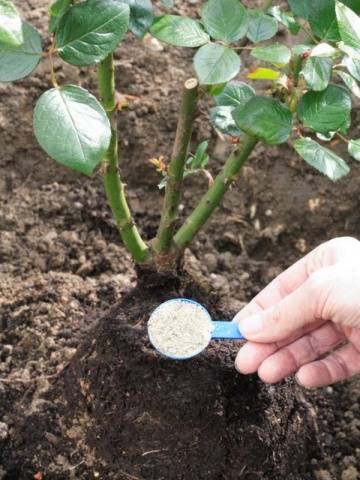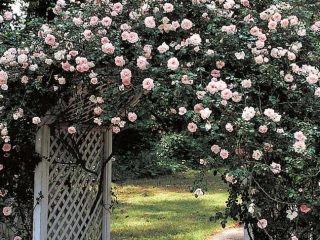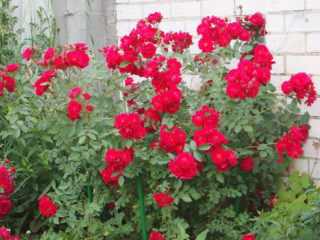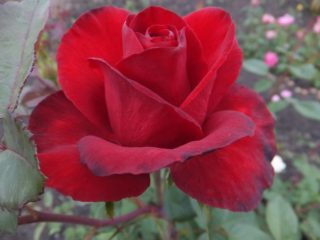Content
Climbing roses are the most popular flowers used for vertical gardening. These plants come in a variety of heights and colors, allowing you to create unique flower arrangements.
But it often happens that the gardener waits for the buds to open, but the climbing rose does not bloom. It's a shame, isn't it? Let's try to figure out what was done wrong.
The rose does not bloom, reasons
Roses refuse to give flowers to their owners for various reasons. This is primarily due to the mistakes of flower growers when caring for the queen of flowers. What other factors influence the lack of flowering, and how to correct the situation.
Insufficiently nutritious substrate
Climbing roses are fastidious plants and grow well in loose, fertile soil. If there is no flowering, you need to find out what the reason is. Most likely, the queen of the garden suffers from soil depletion; the plant does not receive the nutrients it needs for harmonious development.
Feeding scheme:
- After the young plant has been planted, it is fed with organic fertilizers: mullein (1:10) or chicken manure (1:20) is infused and diluted.For each bush from 3 to 5 liters.
- After wintering, when work on the formation of the bush has already been carried out, in order for the climbing queen to bloom, you need to feed it with ammonium nitrate - 30 grams per 1 sq. m. m. Repeatedly after 14 days.
- When the first buds appear, climbing roses are fed with complex fertilizers containing nitrogen. You can use Kemira Lux (30 grams per 1 square).
- At the end of June - beginning of August, complex, nitrogen-containing fertilizers are used again.
- The last feeding should be done closer to autumn, when the roses stop blooming. Its task is to obtain well-ripened shoots. So that in the spring the question does not arise as to why climbing roses do not bloom, the plant is fertilized with superphosphate - 30 grams per square.
There is no flowering if the soil under the plants is compressed. Loosening is a mandatory procedure.
Lots of growth
The presence of a large number of shoots in the root zone may also be the reason why a climbing rose does not want to bloom. Overgrowth that is not removed in a timely manner turns into wild growth. In addition, it sucks out nutrients and the cultivated shoots turn out weak.
The root shoots are cut out close to the ground. Thinning should be done with the onset of warm days. Any damage or freezing in winter makes the plant weak. More shoots growing inward are removed. The diagram is shown in the photo.
After the rose bush has faded, you also need to prune it.
A few secrets for pruning climbing roses:
- Use sharp, disinfected instruments;
- First of all, cut out the buds directed into the depths of the bush;
- Cut the shoot obliquely, without long stumps.
Problems associated with fertilizer
Excess or lack of nitrogen fertilizers can cause climbing roses to not bloom.
If plants are overfed with nitrogen, they intensively “drive” the green mass, and buds do not form. You can add potassium salt to the soil by mixing it with superphosphate.
Wood ash extract is an excellent natural fertilizer containing potassium. It can be used instead of store-bought fertilizers.
Other reasons
Diseases affect the possibility of flowering
If you decide to find out why a climbing rose does not bloom, check to see if the plant is sick. Most often, flowers are affected by powdery mildew or bark cancer. What to do if the disease is present?
Let's consider the necessary measures:
- against powdery mildew, buds and shoots are sprayed twice in early spring with a one percent solution of Bordeaux mixture; the same measures can be carried out as preventative measures. There will be no harm;
- To prevent cancer, it is necessary to timely feed climbing roses with fertilizers containing potassium and to properly cover the plants for the winter.
Among the reasons is the wrong landing site
The queen of the garden does not form buds and does not bloom if there is a lack of light. In addition, shoots do not develop properly in the shade. Due to strong stretching, they do not have time to ripen and may freeze in winter. The dead plants will be weak and unlikely to bloom.
A large amount of light also has a detrimental effect on the ability of climbing roses to bloom. A lot of buds can form, but the hot sun burns them.
What rules for planting roses must be followed:
- For the queen of flowers, a well-lit place is selected, but at noon, direct sunlight should not hit the plant.
- Climbing roses need to be protected from the north wind. Cold weather may cause the plant to not bloom.
- Trees on the site should remain away from roses. Like a real queen, she doesn't like to share space with anyone. Moreover, trees have a powerful root system; no matter how you feed the flowers, they will always lack nutrients.
Plants did not overwinter well
Autumn work is an important event. If they are carried out poorly, in the spring you will inevitably ask the question: last summer the rose bush bloomed wildly, but now it does not please with flowers.
In autumn, wild shoots are cut out and weeds are removed. Until the vine freezes, it is bent to the ground. To prevent the shoots from rising, they are carefully pinned down. To save plants from low temperatures and excess moisture, a shelter is made over the roses. It can be made of plastic film or boards.
If it is not there, the climbing roses may wither away. Then there can be no talk of any flowering in summer.
Good luck
Growing roses is a fascinating activity, but without knowledge nothing good comes of it. In order for your climbing roses to become a real decoration of your site, you need to learn the rules of caring for them.
Look how beautifully the numerous flowers are spread out on the fence.
A huge blooming bouquet of roses with an inimitable aroma!
















